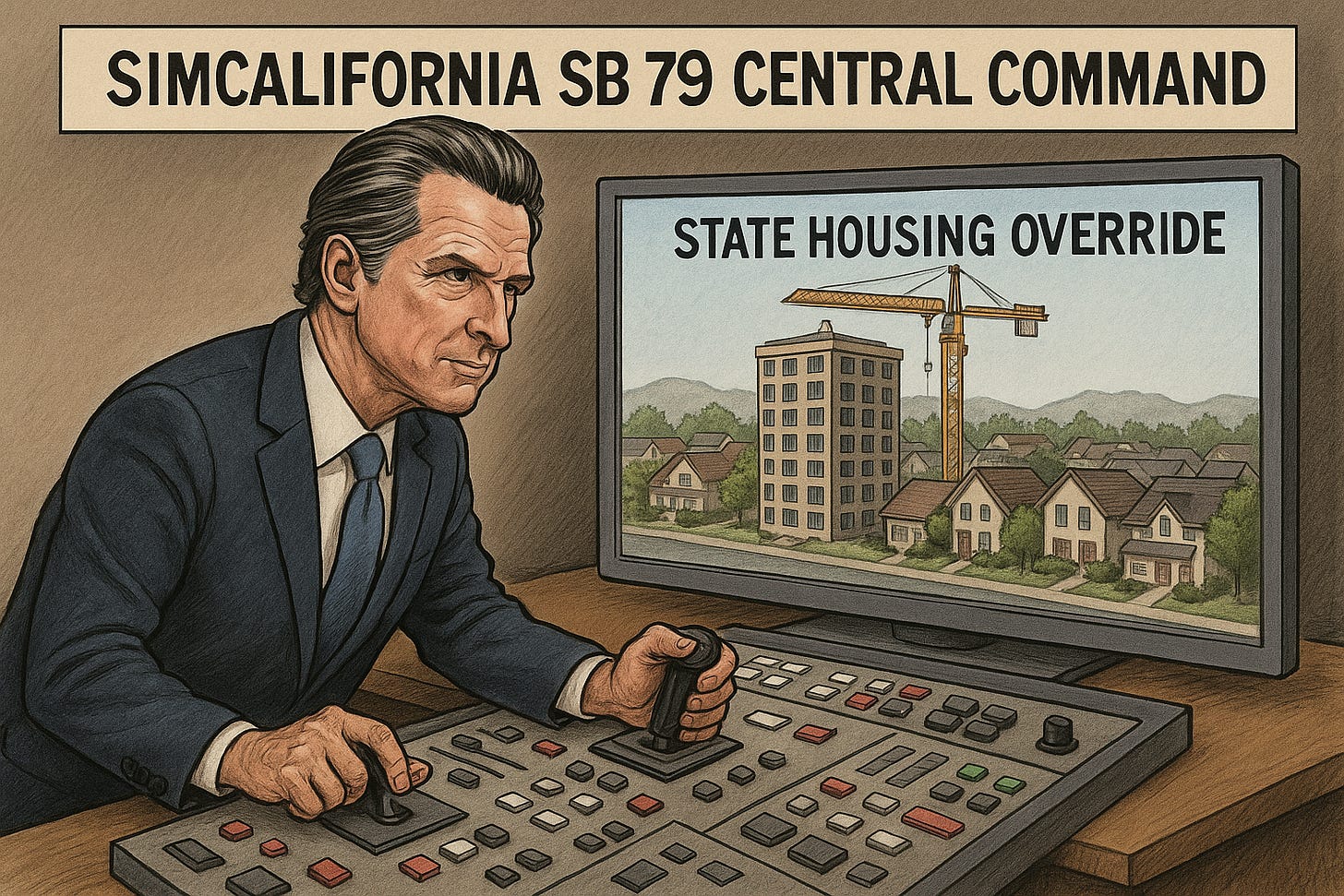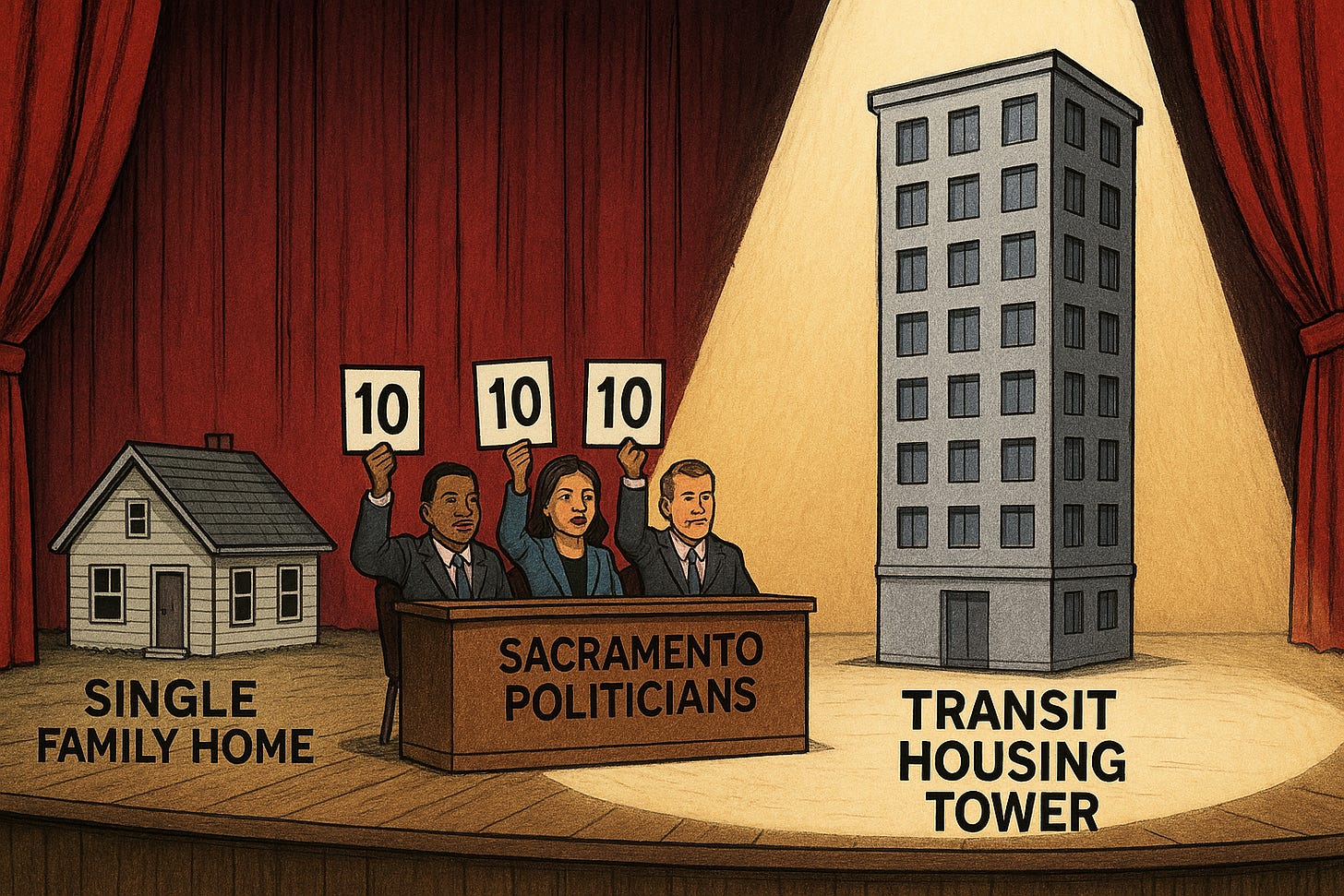Newsom’s Forced-Density Fix Won’t Solve California’s Housing Crisis
SB 79 fast-tracks subsidized high-rises near transit, but leaves the real roadblocks untouched.
This column really talks about, in great detail, why SB 79 is a terrible law. For our paid subscribers, after this column, is a strong list of policies that should be adopted that would actually start to make housing great again in California.
⏱️ 4.5 min read
The Illusion of Progress
California’s housing crunch didn’t appear out of thin air. For decades, state policies have piled on taxes, fees, and regulations that drive up construction costs and slow building. Endless permitting delays, CEQA reviews, impact fees that add tens of thousands, and union labor mandates push the average California home over $800,000—pricing out families and forcing brutal commutes.
Enter SB 79, touted as a bold step to add more housing for the Golden State. At first glance, it seems straightforward: Developers get the green light for taller buildings—up to nine stories in some zones near public train or bus stops. The pitch is to cluster homes near transit, supposedly easing traffic and boosting affordability.
A Narrow Mandate Instead of Broad Relief
But this falls far short of a real solution. It doesn’t repeal the burdensome rules that stifle housing across the board. It fast-tracks one specific type of project while leaving the rest of the market tangled in red tape. If Sacramento truly wanted to unleash supply, it would lower fees, streamline approvals everywhere, and rein in union-driven costs. That would let the market build where demand is—not just where lawmakers decree.
SB 79 mandates “affordable housing,” requiring developers to set aside below-market units for people under a specific income threshold. While this may sound benevolent, it raises costs for market-rate units, as builders pass subsidy costs to other buyers or renters—making housing even pricier for the middle class.
Ignoring What Californians Want
SB 79 is a progressive planner’s dream: cramming higher populations into dense urban and suburban areas, whether Californians want that or not. Authored by ultra-liberal San Francisco Sen. Scott Wiener, the bill assumes everyone wants a planner’s vision of transit-first, car-free living. But that worldview—shaped by dense city living—ignores the millions who prefer single-family homes with yards, garages, and space.
This law doesn’t stop at urban cores. It reaches suburban areas in major metro counties—anywhere near a qualifying transit stop—no matter how out of place. That’s a huge shift imposed from the top down.
The Cost of Urban Chaos
High-density living brings well-documented problems: elevated crime, chronic homelessness, and civic disorder. FBI data shows violent crime rates in cities like Los Angeles and San Francisco are often higher than in surrounding suburban or rural areas. Property crime also tends to be more concentrated in dense urban zones. And encampments near transit stops destabilize neighborhoods, not just aesthetics.
For most families, this isn’t the American Dream. They want safe, quiet neighborhoods—not the noise and disorder of crowded transit hubs.
A Market Tilted Against Freedom
This policy distorts incentives. By giving special treatment to towers near transit, the state tilts the playing field against lower-density options. Single-family developments—especially in the Central Valley or Inland Empire, where land is affordable—get sidelined. Why build a modest subdivision when towers get fast-tracked
Every new single-family home triggers a chain of upgrades—condo owners move up, renters move in. That’s how the housing supply grows across the board. But Sacramento isn’t chasing prosperity—it’s chasing density as an ideological goal. High-rises might work in San Francisco’s core, but dropping them into suburban communities will strain infrastructure and will alter neighborhood character.
This bill entrenches a two-tier system: fast lanes for favored projects, maintaining barriers for everyone else. It’s the government picking winners and lo, ers—warping the market to fit a progressive vision instead of letting supply meet demand.
Eroding Local Control and Twisting Property Rights
One of the bill’s most troubling features is how it overrides local control. Local city councils across California—from major cities to small suburbs—opposed SB 79, warning it strips input and hits resource-strapped areas hardest.
They’re right. Picture investing in a quiet home—then watching an eight-story tower rise next door, balconies peering into your backyard. Progressives call that “equity.” Most would call it an attack on privacy and property values. Local governments exist to balance competing interests—assessing traffic, parking, school impacts, and neighborhood character. SB 79 bulldozes that role, assuming Sacramento bureaucrats know best.
Now I am not defending local governments — far too many of which are overly-restrictive to the extreme, but eliminating their meaninful impact all together? Not a great plan.
And no, this isn’t deregulation. It’s selective intervention. The state says, “If you want to build subsidized high-density housing near transit, we’ll make it easy.” Everywhere else? Tough luck. It’s Sacramento’s top-down urban design experiment—SimCalifornia in real life.
So, Does It Matter?
SB 79 matters because it once again treats symptoms while ignoring the disease. Forced density without fixing the fundamental cost drivers—fees, red tape, union mandates—won’t solve California’s housing crisis. Instead, it creates mismatched development, overburdened transit, and a tidal wave of suburban backlash.
This is what happens when Sacramento prioritizes ideology over economics, and headlines over results. Which it does a lot The state picks winners and losers, stifles natural growth, and overrides the very local leaders best equipped to manage change responsibly.
It means empowering builders, protecting property rights, and respecting that not every Californian wants to live in a high-rise next to a train station.
If this is what Gavin Newsom thinks is good public policy, do we really want him in the White House?
What would real housing reform look like? Six no-nonsense policy ideas California lawmakers could adopt today—if they were actually serious about lowering costs and unleashing the free market.
About 40% of our content is for paid members. The good news? It’s affordable—and you can try it free for a week. Join hundreds of others who have upgraded, and unlock it now!
Keep reading with a 7-day free trial
Subscribe to So, Does It Matter? California Politics! to keep reading this post and get 7 days of free access to the full post archives.




